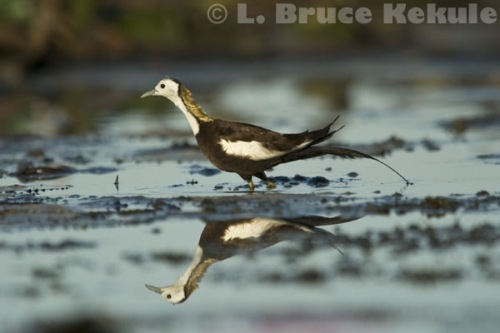Bueng Boraphet – Part Two: Bird Sanctuary in the Central Plains
Thailand’s largest wetland and non-hunting area
Agriculture, villages, housing estates and roads have completely encircled the lake imploding inwards. This pressure is growing as the population increases, with many taking all they can from the lake without thought for the long-term survival of the wild occupants. Approximately 30,000 people live around the margins of the lake. The principal activities in surrounding areas are rice cultivation (one crop of wet-season rice per year), cattle grazing and pig farming. Small areas of corn, beans, cotton and groundnuts are grown in the upland areas around the basin.
Asian golden weaver making a nest
Poaching and encroachment has always been a problem that actually is on the rise. The most dreadful practice of fishing with electricity has been going on for sometime now. About 40 boats from three to four villagers ply to the center of the lake everyday and go about their illegal business right under the noses of those responsible for protection of the lake. It is reported these people are paying protection money for the right to fish in this way. Illegal trap lines and gill nets are also used. These fishing practices should be stopped as soon as possible if there is going to be any future for Beung Boraphet.
Early morning at the non-hunting Area
Over-visitation is another problem when the lake begins to fill during the rainy season. The lake is an important tourist attraction and many people visit it, either to stay at the NHA headquarters or to take boat rides on the lake. A proportion of these visitors hire local boatmen. The main problem is litter thrown in the lake by these people. Education is the best way to cope with this serious predicament.
Cotton pygmy goose – two males and a female
For quite sometime now, local government officials have been in the planning stages of building a hotel and resort golf course on the western shore of the lake. Some earth moving has taken place and this is very detrimental to the already fragile ecosystem plus the demand for water would increase. As it stands, there is very little water in the lake during this serious drought affecting the country at the moment. The levels have reached an all-time low and have created serious problems for the birds in the breeding area. There are only about 20 nesting pheasant-tailed jacana in the non-hunting area that is way down from a decade ago.
Pheasant-tailed jacana and reflection
The FD is responsible for the lake and allows fishing that is abused by some people. The lake is also littered with thousands of discarded nets, trap-lines and bamboo fish-traps strewn all over the place. New ones are continually added on a daily basis with old ones discarded in place.
Fisherman and boat hauling new fish traps
This should be a top priority for both the FD and DNP, plus the local people and government municipality should work together in a massive cleanup. It can only benefit the long-term survival of this unique ecosystem. However, pollution and insecticide runoff from all the farms surrounding the lake has probably already damaged the water quality.
Grey heron – winter visitor
It will be a tough battle but it is hoped that steps will be implemented by those responsible. Time and money can go a long way into helping the future of this place. The lives of so many birds and other creatures are at stake as modernization wrecks havoc on the Kingdom’s natural heritage. Swift and determined action is the only alternative.
Water lillies at the breeding area
The future of dams in Thailand
As we progress into the 21st Century, it has become apparent the construction of large-scale dams is back on the drawing boards. The Kingdom’s natural heritage evolved over millions of years into some amazing forests and watersheds. These ecosystems give life to the nation for without water, life cannot be sustained.
Greater adjutant in Beung Boraphet
Thailand does not need anymore large-scale dams under the ‘Thai Kem Kang’ banner that will destroy natural forests, especially the Kaeng Sua Ten dam projected to inundate 20,000 rai of the last great teak forest in Mae Yom National Park in the north. In October last year, the government announced the construction of Huai Samong dam (now under reconsideration) that will flood thousands of rai between Thap Lan and Pang Sida national parks, both World Heritage Sites putting their status in jeopardy. Other projects on the table are a dam in Mae Wong National Park, Kampangphet province and another in Phu Khieo Wildlife Sanctuary, Chaiyaphum province. None of these projects can be justified if they destroy forests.
Purple swamphen in Beung Boraphet
To get a better prospective of the serious situation facing the country, drive around and look at the dried-up reservoirs, and then ask yourself, do we need another dam? The main problem is the lack of rain (global warming and forest destruction). Most hydro-dams and reservoirs are in serious trouble if rain does not come soon. The solution; money to be used on construction of these dams should go to rain-making programs under His Majesty the King’s initiative plus reforestation projects, small check-dams that do not destroy large swaths of forest, and alternate green power sources like solar and wind.
It does not take a rocket scientist to understand what is going down between politicians and the proponents of dam projects. It is truly disheartening how these influential people carry on with absolutely no respect for Thailand’s wild heritage.
And worst of all, corruption cannot be broken or even dented when these mega-schemes come into play. The immediate prospect is bleak as politicians attempt to wreck havoc on the nation’s natural resources. When will it ever stop? We need to preserve and protect the last remaining forests for the future, or the consequences could be dire.










